Jump to:
Looking to learn more about the 7 types of fades? Don’t worry – you’re in the right place. We’ll show you 7 different fade types, examples of each, why we love each one, and tips to help you decide which type will look best on you.
Quick Note: We’ve linked all of our separate fade haircut style guides into this guide. Under each of the 7 types, just click the corresponding link to learn more about the style and see examples.
Wait, There Are Types of Fades?
Fades are easily the most popular haircut for men. One reason they’re the top guy style is their versatility. There are so many different types of fades and ways to customize the cut!
From the length to the way you style the hair on top, making a fade your own is as simple as knowing the look you’re going for. If you’re wondering what your fade options are, you’re in the right place.
But with so many types of fades, which one will look best on you?
We’ve got a list of the different types of fades, how each fade looks on different hair types, and tips for making the most of your next fade haircut. From drops to bursts, there’s a style for everyone.
The 7 Main Types of Fades:
In this complete guide, you’ll see styles ranging from classic and clean-cut to bold and precise. As you check out the different examples, make note of the styles you like best. When you’re ready for your next haircut, you’ll know exactly what to ask for.
What’s a Fade?
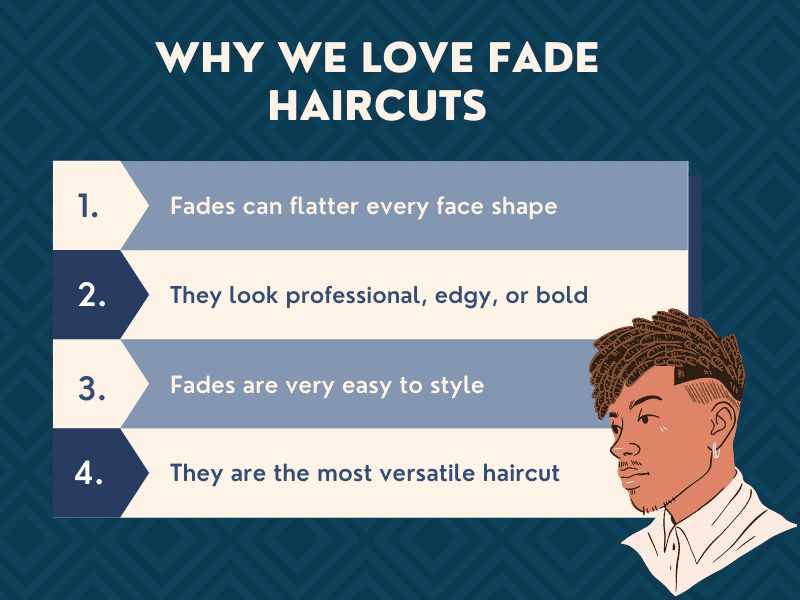
A fade haircut is one where longer hair on top is cut to progressively shorter lengths on the back and sides. Clippers are typically used to create a seamless fade with perfectly blended sections.
Fades can feature any length of hair on top – we’ve seen some great taper fades with super-long hair on top, and others where the hair looks nearly buzzed on top. The key is that the hair on the back and sides will be shorter, and that each section of hair will be cleanly transitioned, or faded, into the next shorter section.
Conventional or classic fades don’t require much maintenance (but more complex fades do). Typically, you’ll need a trim every 4-6 weeks to keep a fade looking sharp.
If you decide on a simple classic fade, you may even be able to cut your own hair and handle the trims yourself. Just make sure you’re using the best clippers you can afford! It makes a huge difference.
A few things we love about fades:
- Fades can flatter every face shape and work with every hair type
- This type of haircut can look as professional, classic, trendy, or bold as you want
- Styling is easier with the short back and sides – just style the top, and you’re ready to go
- It’s the most versatile haircut for men and never goes out of style
- Some are easy enough to do a fade haircut at home
Let’s check out some examples of the different types of fades you can choose from. You might find the inspiration for your next haircut!
The 7 Basic Types of Fades
Since the barber industry is always morphing and adapting to new style trends, it can be hard to keep up with all the fade types you see. That’s understandable – there are literally hundreds, maybe thousands of ways to wear a fade.
But there are just seven basic types of fades that underlie all of these modern, trendy styles. These seven core fade types have a ton of versatility.
- Each one can be mixed and matched, borrowing components from other fade types.
- They can be worn on different hair textures, like fine, medium, and coarse hair.
- They can feature different hair lengths (like a longer top or shorter back and sides) to switch things up.
- They can be worn on different hair types, like straight, wavy, curly, or coily, for completely different looks.
See the seven basic types of fades and a few ways to wear them below.
1. High Fade
A high fade is a contemporary fade that starts higher up on the head around the temples instead of midway above the ears. The hair on the sides and back is typically very short, sometimes even shaved down to the skin (called a skin fade, which we’ll also cover in our list). Since the fade starts “high up” on the head, this cut is fittingly called a high fade.
The stark contrast between ultra-short hair high up on the back and sides and longer hair on top is what makes the high fade a favorite style. There are tons of ways to wear it, but these two examples show off the versatility.
High Drop Fade
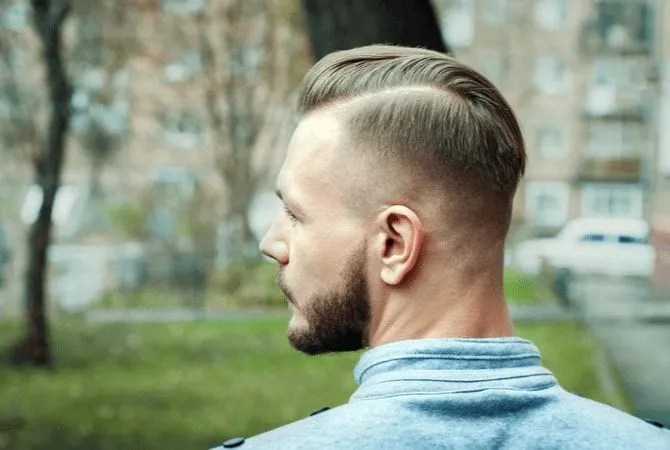
Vikafoto33/Shutterstock
You’re already beginning to see how different fade types can be mixed and matched to make new, unique styles. Here, the drop fade (see how it dips down in the back?) is combined with the high fade for a modern twist on a classic.
Hi-Top High Fade with Designs
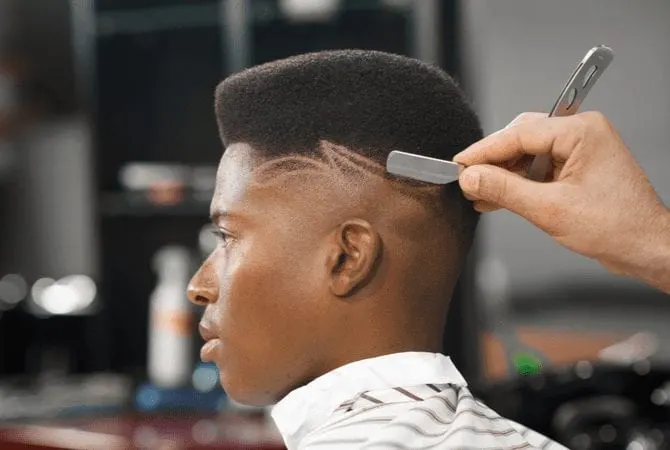
Serhii Bobyk/Shutterstock
This throwback look is coming back, and if you’ve got the hair for it, it’s a great style to try. A high fade brings the fade line all the way up to the temples, and the hair on top is left long enough to style up with a flat hi-top. We love the shaved design along the fade line.
2. Medium Fade
Medium (or mid) fades start lower down than high fades, usually midway above the ears. If you close your eyes and picture a classic fade, a medium fade is probably what comes to mind. These clean-cut classics keep the shorter portions of the hair toward the bottom for a perfectly balanced look.
Mid fades can look great on any hair type and with any length on top. We’re partial to a clean-cut medium fade that keeps the hair on top neat and short. If you’re itching for a bolder style, try a high fade.
Military Medium Skin Fade
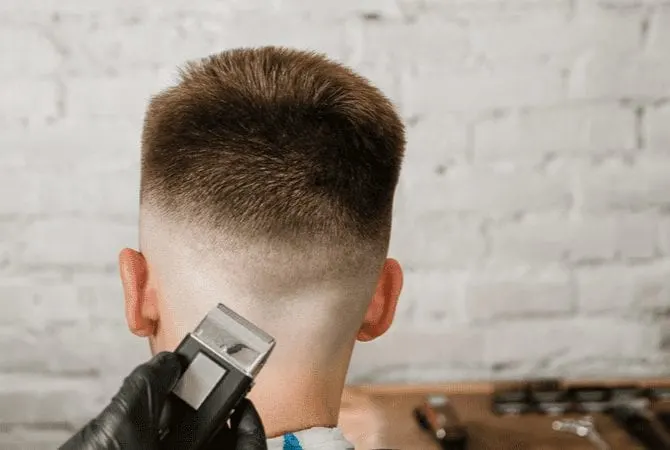
Vikafoto33/Shutterstock
This fade begins just above the ears – not high or low, so it’s a classic medium fade. The shortest clipper guard sizes are used here to shave the fade down the skin. The hair on top is left longer, and it gradually tapers down to the shorter fade lengths on the back and sides.
Medium Drop Fade

AJR_photo/Shutterstock
Drop fades dip down in the back, and while this is a very tame example of a drop fade, it perfectly illustrates what a medium fade is. This is a great clean-cut look that works well with short to medium-length hair on top.
3. Low Fade
While high fades begin around the temples and medium fades start midway above the ears, low fades have a lower fade line around the ear level. This kind of fade makes the hair appear longer because the long portion covers more of the head than the short, faded portion.
We like low fades on any hair type or texture. They look great when combined with longer hair on top.
Slicked Back Low Fade
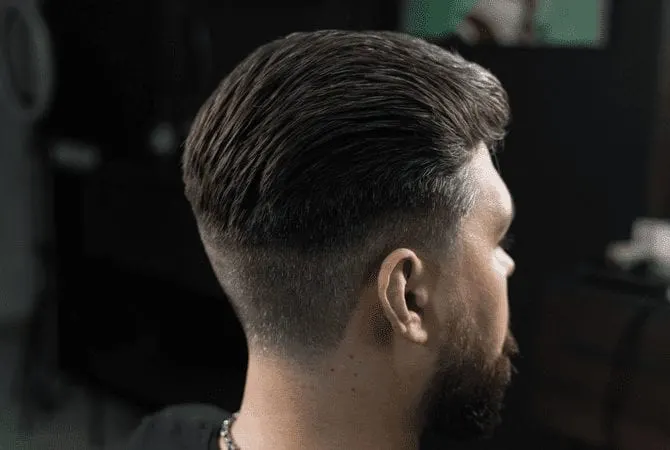
Rabizo Anatolii/Shutterstock
If you’re not sure about the look of skin fades, you can always leave a little more length on the bottom and try longer hair on top for a slicked-back low fade like this. We like the long top pushed back for a debonair style that works on straight, curly, wavy, or coily hair.
Blown Out Low Fade
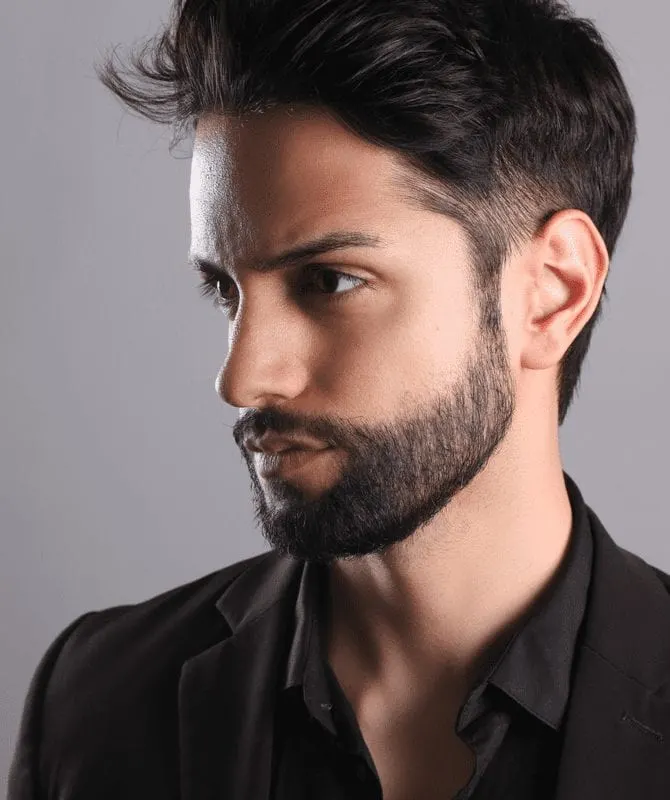
Rdrgraphe/Shutterstock
One reason we like longer hair on top with low fades is the number of styling possibilities it creates. When the hair on top is long enough, you can dress up a low fade with a blowout style like this. Apply a little mousse to damp hair, then blow dry the hair backward with a round brush for volume up front.
4. Drop Fade
Drop fades can start high, medium, or low, but they all have one thing in common: The fade line at the back of the head is brought down lower than on the sides. The result is a dip in the fade line, hence the name “drop fade.”
There are a lot of different looks you can get from drop fades. Start it high, low, or somewhere in between. Make the drop rounded or pointed. Style the hair on top into a quiff or mohawk for a bold look. Or, leave the hair on top short and groomed for a low-maintenance look.
High Drop Skin Fade
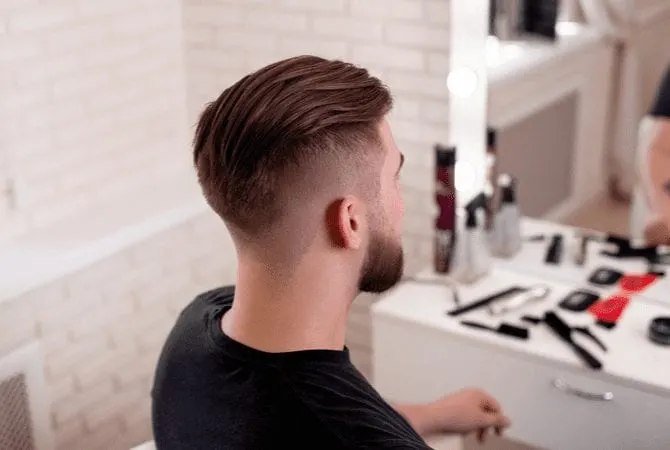
Galyakiss/Shutterstock
This example shows how you can combine elements from different fade types to create something truly unique. Here, the barber combined the height of a high fade, the dip of a drop fade, and the super-short length of a skin fade into one modern style.
Mohawk Pointed Drop Fade
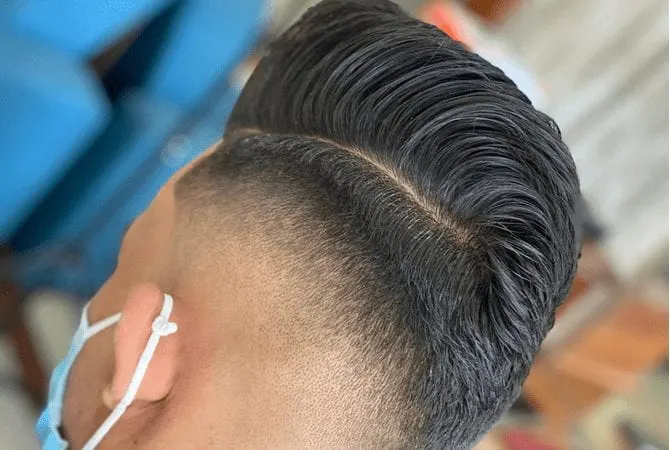
Arul Kakap/Shutterstock
This is a great example of how creative you can get with fades! The hair on top is left long enough to style into a mohawk. The sides are faded up high along the temples and gradually dip down into a point at the back (the drop portion).
5. Skin Fade
Skin fades are sometimes called zero fades or bald fades. Skin fades can be any type of fade, but they all have one thing in common: The hair is shaved down the skin at the shortest part of the fade.
If you want a high-contrast look that gets attention, requires precision, and looks tough, get a skin fade. Be aware that skin fades will show large portions of your scalp, which will be much lighter than your skin tone. You might need to start wearing sunscreen on your head after getting your first skin fade.
Caesar High Skin Fade
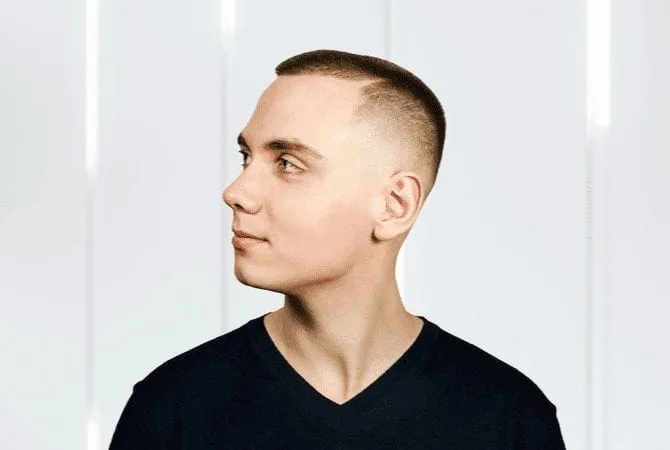
Vikafoto33/Shutterstock
Keeping a short, even fringe at the front hairline makes this a Caesar-style cut, and where the fade line begins (at the temples) makes it a high fade. Since the fade is shaved down to the skin, this is a great example of a skin fade.
High Drop Skin Fade
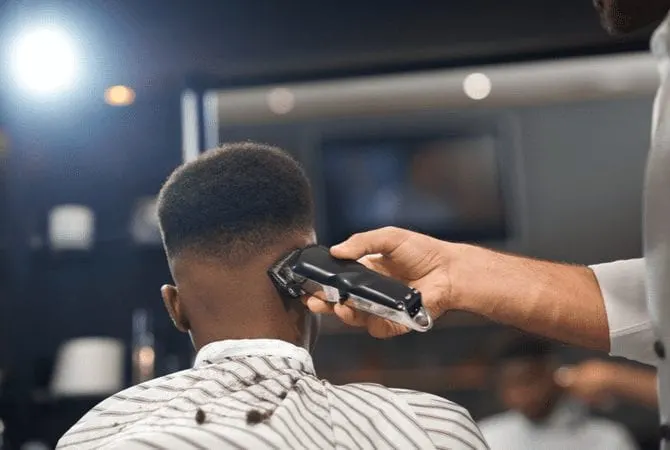
Serhii Bobyk/Shutterstock
Keeping coily hair long on top gives you more styling possibilities, and we love the pointed drop fade line at the back. Shaving the hair down to the skin below the fade line is what makes this a skin fade. This is a clean, precise look that will require a little more maintenance to look its best.
6. Temple Fade
Precision is the name of the game with temple fades, also called temp fades or Brooklyn fades. With temple fades, the hair at the temples is shaved and cut with clippers into a line-up or shape-up design. Behind the temples, the fade line continues.
The goal with temple fades is a precise line that perfectly incorporates the gradual shortening of the fade. Temple fades can be combined with any type of fade – drop, skin, burst, etc. – but they are usually done on high fades because other fades don’t start at the temples.
90 Degree Temple Drop Fade
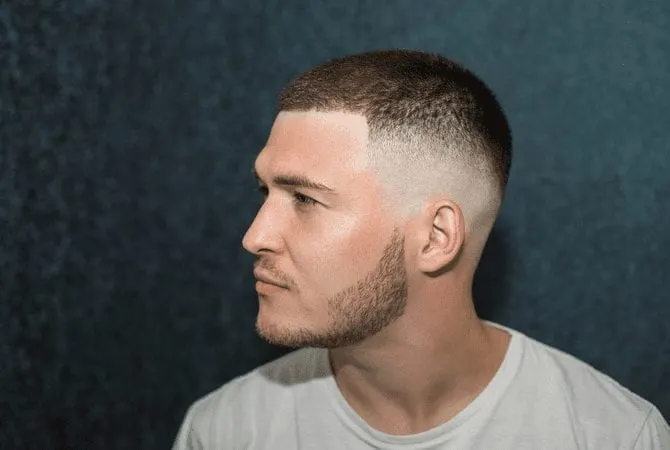
Vikafoto33/Shutterstock
A classic example of a temple fade, this man’s cut incorporates a precise 90-degree angled notch at the temples. Behind that, the fade line continues before dipping down in the back to form a drop fade.
Shaped Up High Temple Fade
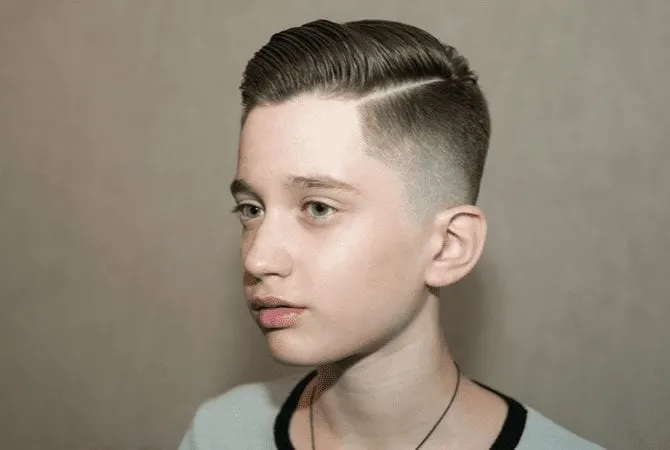
Vikafoto33/Shutterstock
This kid’s got style with his shaped-up temple fade! Here, the barber created a high fade and shaped up the hairline at the temples for a little more precision. Combined with a suave side part, it looks perfect.
7. Burst Fade
Burst fades take on a semi-circle shape that surrounds the ear. The fade line uses the ear as a center point and moves in a circle shape around it. They are similar to drop fades because the fade line appears to dip down at the back of the head.
Burst fades can be combined with any type of fade to create more unique looks. Since the hair around the ear is tapered in length, you can choose to have it go down to the skin or leave a little hair for a lower-contrast look.
Coily High Burst Fade
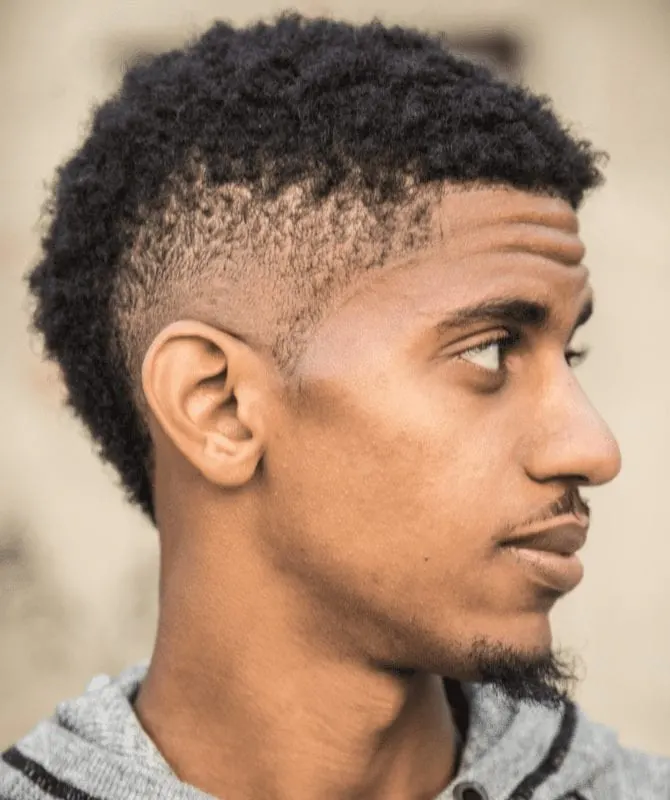
Erik Van Ingen/Shutterstock
The shorter areas of this fade seem to originate from the ear, making it a burst fade. But since it extends upward a little further, it becomes a high burst fade. This is a great look on coily hair especially.
Side Parted Burst Fade
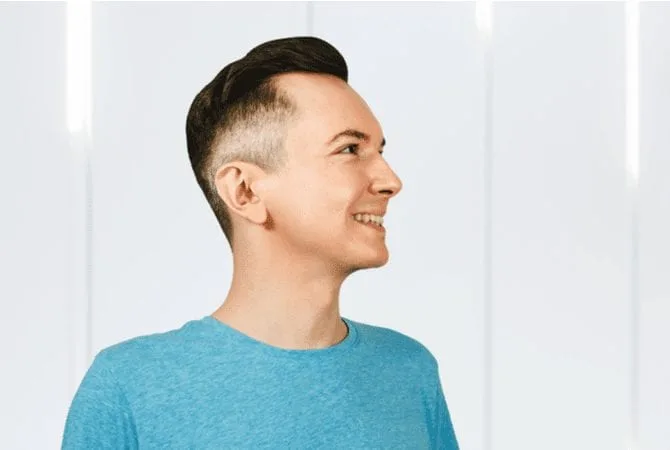
Vikafoto33/Shutterstock
Here, the hair is parted to the side and slicked over with a little gel for hold. The “burst” part of the fade ends just behind the ears, letting the hair appear to dip down in the back for the drop portion of this cut.
Which Type of Fade Works for You?
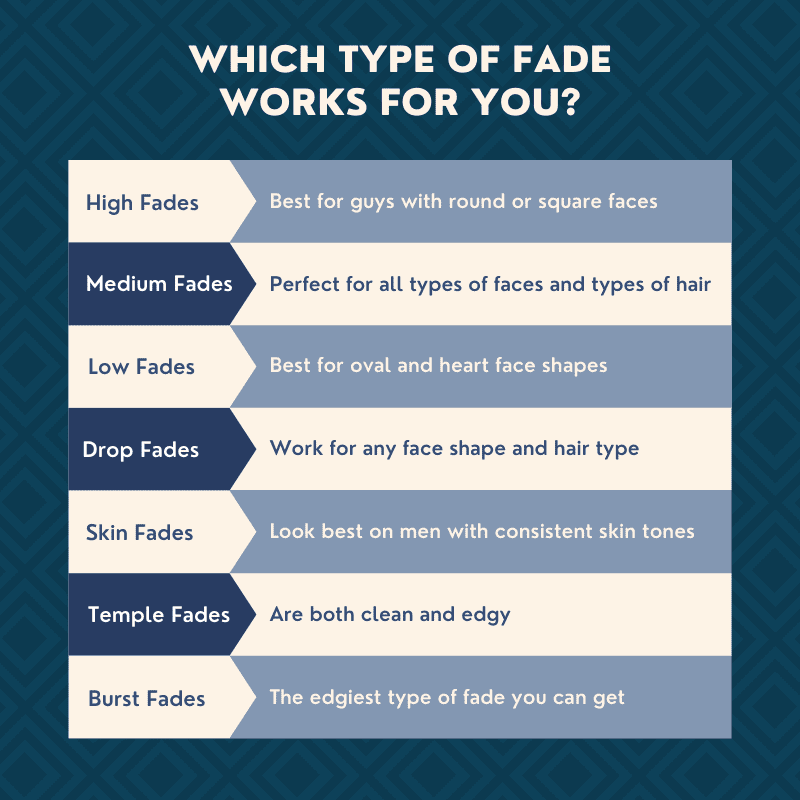
Now that you’ve seen the seven basic fade types, which one is going to be the best look for you? You can always experiment with different types to find your favorite, but if you’d rather skip the trial and error, follow these tips to find the fade type that will look best on you.
- High fades are best for guys with round or square faces, especially if you leave a little more length on top to add height. Avoid high fades if you have a long oval face or a heart-shaped face. This kind of fade can make oval faces look longer, and heart-shaped faces look more pointed.
- Medium fades work perfectly for all face shapes because they’re all about creating balance. Try a medium fade if you have a round, square, heart, or oval face – it will look great! The only thing you need to decide is how long you’ll leave the top.
- Low fades create visual weight at the top and middle of the head, making them a bad choice for round faces. Square faces tend to look even more chiseled with a low fade accentuating the face shape, and this kind of fade also works for oval and heart-shaped faces.
- Drop fades can work for any face shape and hair type. There’s so much versatility here – the shape, height, and depth of the drop can all be experimented with to find the best look. Try combining a drop fade with the type of fade that looks best on your face shape – high, medium, or low – for a new twist on a classic look.
- Skin fades can be done on any type of fade, so they can work for any face shape or hair type. However, skin fades look best on men with even, consistent skin tones because they will show large portions of your scalp. If your scalp hasn’t seen the sun in a long time, it’s going to look much paler than the rest of your skin and change the overall look of the fade.
- Temple fades create a little design right at your temples and indicate where the fade line starts. If you like a clean, precise look, give a temp fade a try. They look great when paired with a high skin fade.
- Burst fades leave more hair at the back of the head, usually extending all the way down to the neckline. The only area that is “faded” is the semi-circle section around the back of the ear. Any face shape can work with a burst fade, so feel free to try a burst fade if you like the look!
With so many fade types and looks out there, it can be a little overwhelming to choose the style you want. We encourage you to experiment with different types of fades to see which style looks best on you. Try combining your favorite components of 2 or more fade types to create a look that is uniquely you.
